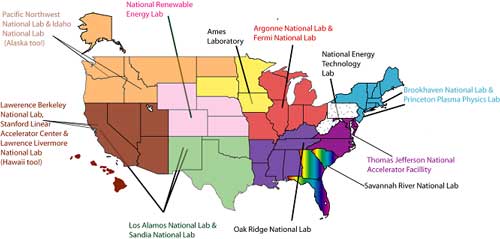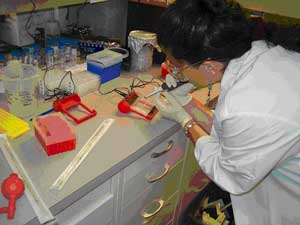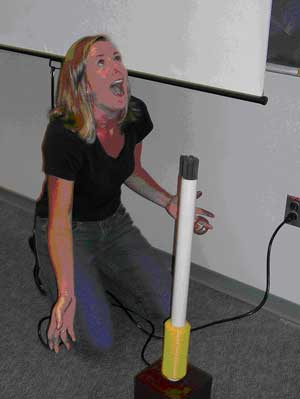Forum on Education of The American Physical Society
Summer 2006 Newsletter
|
US Department of Energy (DOE) Professional Development for K-12 Teachers: The Laboratory Science Teacher Professional Development (LSTPD) Program Provides K-12 Science Teachers Research Opportunities at the DOE National Laboratories Todd Clark and Jennifer Coughlin In his State of the Union Address, President Bush stated, "We need to encourage children to take more math and science, and to make sure those courses are rigorous enough to compete with other nations." [i] The National Academies' Rising Above the Gathering Storm states, "Improvements in student achievement are solidly linked to teacher excellence, the hallmarks of which are thorough knowledge of content, solid pedagogical skills, motivational abilities, and career-long opportunities for continuing education." [ii] Furthermore, in recent testimony before the House of Representatives Science Committee, Dr. James Decker, Principal Deputy Director of the Office of Science, US Department of Energy stated, "The two most important ways the Federal government can improve science and math education is first to help ensure that there is a highly qualified teacher in every classroom and second, to help ensure that students have the opportunity in their schools to study science and math every day of the school year and every year throughout their K-12 education." One proposed solution to this method would be by "incorporating K-12 STEM teachers into the scientific community of the National Laboratories, teachers are provided many of the tools they need to improve their professional performance, their leadership abilities in the STEM education communities, and most importantly, their students' achievement." [iii] For this reason, Secretary Bodmann has suggested a proposed budget in 2007 to expand the DOE role in science and mathematics education by expanding its Laboratory Science Teacher Professional Development (LSTPD) program. The DOE has always been supportive of science education, but reestablished their role in teacher professional development in 2004 when the U.S. Secretary of Energy Spencer Abraham announced a new science education initiative to reinvigorate the DOEҳ involvement in K-12 science education. [iv] Part of this new initiative is the LSTPD program. The LSTPD program has received new attention as part of the President's American Competitive Initiative, and the expected budget for 2007 will allow the DOE to triple the number of participating teachers and more than double the number of DOE National Laboratories hosting an LSTPD program. The Office of Science at the DOE designed the LSTPD program with teacher input and using current research and standards for the best practices of teacher professional development. The programҳ objectives are to help teachers become ambassadors for the science community to students and their parents, agents for positive change in science education, and the inspiration for the next generation of scientists, engineers, technicians, and mathematicians that support scientific research for the DOE and the United States. The DOE has incorporated the latest research and standards for teacher professional development into the LSTPD program. The National Science Education Standards [v] list four standards for professional development of teachers of science that serve as the foundation for the LSTPD program design. In addition, research from the American Institutes for Research [vi] and publications from the National Institute for Science Education's Professional Development Project [vii] were used in the program design. Current LSTPD teachers make a three-year commitment to the national program, but are allowed to move between seven DOE labs. The seven labs participating include Argonne National Lab near Chicago; Brookhaven National Lab on Long Island, New York; Lawrence Berkeley National Lab in the San Francisco Bay area; the National Renewable Energy Lab near Denver, Colorado; Oak Ridge National Lab in eastern Tennessee; the Pacific Northwest National Lab in Washington; and the Thomas Jefferson National Accelerator Facility near Norfolk, Virginia (Table). With the anticipated additional funding in 2007, the LSTPD program will grow to run at up to 17 DOE National Laboratories. Teachers may participate in programs at the same lab for all three summers, or they may move between programs during successive summers. Each participating lab is required to design a program or programs using one or more of the following formats. Table. Participating labs and programs, during current pilot program
Teachers receive a stipend, in addition to funding for travel, housing, professional development, and purchasing lab equipment for their classrooms. The commitment goes far beyond time during the summer, as teachers are expected to collaborate during the school year. Teachers, scientists, and program managers designed the LSTPD program to:
Proposed Regional Assignments for 2007 if funding allows
Preliminary data on the potential success of the program are hopeful. The program has a ninety-five percent retention rate and has to date provided over seventy thousand dollars in funds for science and math resources. The program is inspiring our teachers to become leaders as evidenced by increased participation and presentation in conferences and awards such as the prestigious Milliken Award. The teachers themselves provide very positive feed back regarding their participation in the LSTPD program. For example: "LSTPD has had a significant effect on my leadership within our group of science teachers in our building and with the science specialist that coordinates instruction for all of Richmond City science. I am looked upon as a source of information and teaching ideas as well as a resource to draw upon lab suggestions and curriculum guidance." LSTPD Teacher, Jefferson Laboratory "LSTPD has increased my confidence in speaking to other teachers. I have a better understanding of the content and I also have super hands-on materials to help me." LSTPD Teacher, Jefferson Laboratory "I had become ingrained in the history of old science and was no longer embracing new science. This experience renewed my questioning ability and inquisitive attitude." LSTPD Teacher, Oak Ridge National Laboratory This program increases science teacher credibility because participants will be science and mathematics teachers who have actively engaged in the process of research in their fields. With increased credibility, these teacher-scientists will be better able to advocate for positive changes within the system that will improve science and mathematics education for all students.
References: [i] President George W. Bush, State of the Union Address. January 31, 2006. http://www.whitehouse.gov/news/releases/2006/01/20060131-10.html [ii] Augustine, N.R. Rising Above The Gathering Storm: Energizing and Employing America for a Brighter Economic Future. National Academies Press (2006) [iii] Decker, James. March 30, 2006 - Full Committee - Hearing - K-12 Science and Math Education Across the Federal Agencies http://www.house.gov/science/hearings/full06/March%2030/decker.pdf [iv] Abraham, S. 2004 Remarks by Secretary of Energy Spencer Abraham at the Stanford Linear Accelerator Center on July 8, 2004. http://energy.gov/news/1390.htm [v] National Research Council (NRC). 1996. National science education standards. Washington, DC: National Academy Press. [vi] Birman, B., L. Desimone, A. Porter, and M. Garet. 2000. Designing professional development that works. Educational Leadership 57 (8) 28-33. [vii] Loucks-Horsley, S., P.W. Hewson, N. Love, and K.E. Stiles.1998. Ideas that work: Science professional development. [viii] Seastrom, M. M et. al. Qualifications of Public School Teacher Workforce: Prevalence of Out of Field Teaching 1987-1988 to 1999-2000 (Washington, DC: U.S. Department of Education, 2002). [ix] Increasing the Odds: How Good Policies Can Yield Better Teachers. National Council on Teacher Quality. 2006 This article contains material originally published in 'The Science Teacher, Summer 2006', Copyright (C) National Science Teachers Association, all rights reserved. On the web: LSTPD Program: www.scied.science.doe.gov/scied/LSTPD/about.htm Todd Clark (todd.clark@science.doe.gov) is a science education advisor at the Office of Science, US Department of Energy, 1000 Independence Avenue, SW, Washington, DC 20585. Jennifer Coughlin (Jennifer.Coughlin@scinece.doe.gov ) is an Albert Einstein Distinguished Educator Fellow for the Office of Science, US Department of Energy, 1000 Independence Avenue, SW, Washington, DC 20585. |





